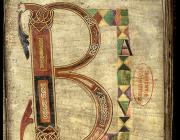2024
2023
2022
2021
Abstract
Long sidelined by art historians, the Wandalgarius Codex is a compendium of legal texts dated to 793 that represents an early venture in a trend associated with the 790s: populating initial letters with lively figures. This article centers the Wandalgarius Codex in discussion of experimental book illumination in the late eighth century. The decade saw re-definition of the visual organization of books, the uses illumination could serve, and the ways manuscripts in many genres reflected and shaped projects of education and reform. The essay sets Wandalgarius’ approach to initials in conversation with the well-known Gellone Sacramentary, and investigates the scribe-draftsman’s characterization of his own work as an ambitious contemporary book-maker.
2020
2019
Abstract
From the dissolution of the Carolingian empire to the onset of the so-called 12th-century Renaissance, the transformative 10th and 11th centuries witnessed the production of a significant number of illuminated manuscripts from present-day France, Belgium, Spain, and Italy, alongside the better-known works from Anglo-Saxon England and the Holy Roman Empire. While the hybrid styles evident in book painting reflect the movement and re-organization of people and codices, many of the manuscripts also display a highly creative engagement with the art of the past. Likewise, their handling of subject matter—whether common or new for book illumination—attests to vibrant artistic energy and innovation. On the basis of rarely studied scientific, religious, and literary manuscripts, the contributions in this volume address a range of issues, including the engagement of 10th–11th century bookmakers with their Carolingian and Antique legacies, the interwoven geographies of book production, and matters of modern politics and historiography that have shaped the study of this complex period.
Abstract
The Cross, the Gospels, and the Work of Artexplores the power of pictorial representation in the Carolingian period—a time when the nature and status of images within the Church was the subject of intense interest and debate. While much scholarly attention has concentrated, as medieval writers did, on the theological problem of images as a material crutch, I propose a counter-current vested in visual argument. Through a focus on the role and character of the cross in the highly charged genre of gospel illumination, the book demonstrates the instrumentality attributed to images and manufactured objects within artworks themselves.
The cross stood at a singular intersection of past, present and future in the early medieval period. In its multivalent nature, the cross’ status as the Church’s central sign reflected the Church’s own position at the crossroads of ages, simultaneously commemorating sacred history, functioning in the present day, and preparing for Judgment and the end of time. While well-recognized visual attributes of the cross communicate its theology relative to eschatology and the Passion, I argue that a formal language also developed specifically to articulate concepts of presence and efficacy in the manufactured sign. As the sign of the present, as well as the future and the past, the cross could then be used to comment on the value of other artworks in its form as an image. The argument proceeds through close attention to strategies of pictorial composition and the architecture of artworks—primarily illuminated manuscripts. It presents a balance of widely known and rarely published examples, mostly from the Frankish lands of the late eighth–early tenth centuries, examining the project and priorities of book-making in light of a broader conception of art's work in the early medieval west.
2018
2017
2016
2014
2013
Abstract
In the mid-eleventh century, Hrabanus Maurus' renowned ninth-century work, In honorem sanctae crucis, was copied at Saint-Germain-des-Prés with the addition of an original programme of illustration to complement the interwoven images and texts constituting Hrabanus' original carmina figurata (Paris, BnF, Ms. lat. 11685). The first section of this paper explores the fundamental difference in conception between the original and the copy, namely, the eleventh-century artist's characterization of the Cross as a material object. The following section ranges beyond the Saint-Germain example, contextualizing its material conception of the Cross with reference both to other copies of In honorem, and to the twelfth-century Prüfening production known as De laudibus sanctae crucis. It is argued that while the materiality of the Cross was an aspect of the sign's identity that Hrabanus sought to avoid, later witnesses portrayed the Cross' material fabrication as a critical element in both the sign's identity, and in the project of a book conceived ‘in praise of the Holy Cross.’
Please contact me for a copy of the paper.
Contact
Department of Art & Archaeology
Princeton University
Green Hall, 2-S-7
Princeton, NJ 08544
609-258-1516
[email protected]
If you need an article pdf, please email me.

